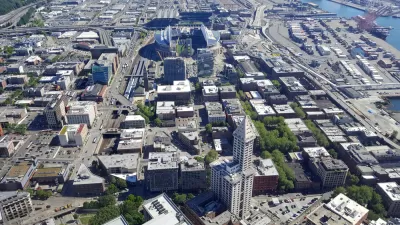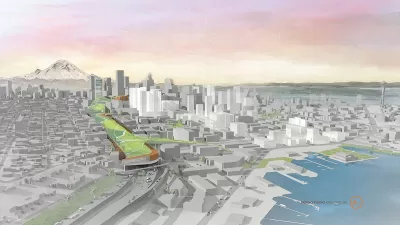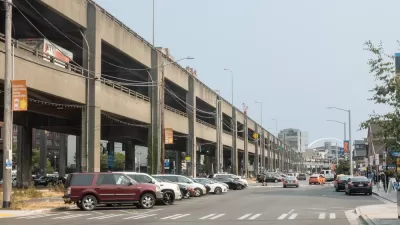The notion of fully capping I-5 as it runs through central Seattle has been gaining steam. The city could stand to gain hundreds of acres of urban land.

An ambitious idea is gaining traction in Seattle, following in the footsteps of the city's waterfront remake. With the Lid I-5 campaign in the lead, advocates are exploring what it would take to fully lid I-5. "During construction in the early to mid 1960s," Knute Berger writes, "it had destroyed some 6,000 homes, slashed through the International District as it cut a concrete canyon through the heart of the city."
But times have changed. Recently, "a city grant has helped come up with concepts for how the new 'land' of a lid — a concrete cover to I-5 strong enough to hold buildings, parks, roads and people — could be used."
I-5 is already partially lidded in several places, like Freeway Park and the Washington State Convention Center. "As part of the package to expand the Washington State Convention Center, $1.5 million has been allocated to the city for an upcoming study of the feasibility of lidding which will be undertaken in 2019."
The project is bound to be expensive, complex, and will likely take many years to complete. But given downtown land prices, Berger writes, much of the cost "could well pencil out." In the meantime, the idea has sparked lively discussion about what might be done with all that new land, and a more cohesive downtown.
See also: A Closer Look at the Ambitious Plans to Cap I-5 in Downtown Seattle
FULL STORY: How capping I-5 could redeem Seattle’s past

Alabama: Trump Terminates Settlements for Black Communities Harmed By Raw Sewage
Trump deemed the landmark civil rights agreement “illegal DEI and environmental justice policy.”

Study: Maui’s Plan to Convert Vacation Rentals to Long-Term Housing Could Cause Nearly $1 Billion Economic Loss
The plan would reduce visitor accommodation by 25% resulting in 1,900 jobs lost.

Why Should We Subsidize Public Transportation?
Many public transit agencies face financial stress due to rising costs, declining fare revenue, and declining subsidies. Transit advocates must provide a strong business case for increasing public transit funding.

Wind Energy on the Rise Despite Federal Policy Reversal
The Trump administration is revoking federal support for renewable energy, but demand for new projects continues unabated.

Passengers Flock to Caltrain After Electrification
The new electric trains are running faster and more reliably, leading to strong ridership growth on the Bay Area rail system.

Texas Churches Rally Behind ‘Yes in God’s Back Yard’ Legislation
Religious leaders want the state to reduce zoning regulations to streamline leasing church-owned land to housing developers.
Urban Design for Planners 1: Software Tools
This six-course series explores essential urban design concepts using open source software and equips planners with the tools they need to participate fully in the urban design process.
Planning for Universal Design
Learn the tools for implementing Universal Design in planning regulations.
Caltrans
Smith Gee Studio
Institute for Housing and Urban Development Studies (IHS)
City of Grandview
Harvard GSD Executive Education
Toledo-Lucas County Plan Commissions
Salt Lake City
NYU Wagner Graduate School of Public Service





























